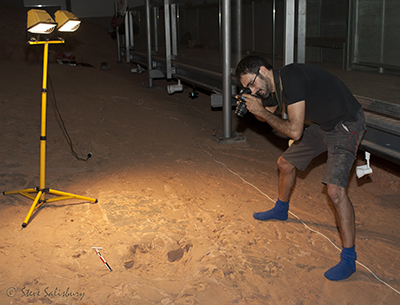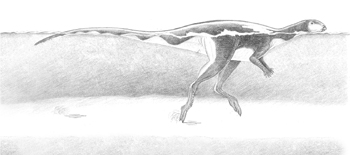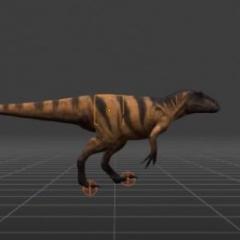
Congratulations to UQ VP & Biomechanics Lab PhD candidate Anthony Romilio on winning the prestigious 2014 Taylor & Francis Award for Best Student Article in Journal of Vertebrate Paleontology
Anthony won the award for his first authored paper on the re-evaluation of Lark Quarry dinosaur tracksite:
Romilio, A., Tucker, R.T., and Salisbury, S.W. 2013. Re-evaluation of the Lark Quarry dinosaur tracksite (late Albian–Cenomanian Winton Formation, central-western Queensland, Australia): no longer a stampede? Journal of Vertebrate Paleontology 33(1), 102–120. pdf + SI
Criteria considered by the panel when judging this award included the quality and originality of research, its importance to the immediate community, its importance to the broader vertebrate paleontology community, and its potential interest to the wider community in terms of public engagement. Judging was based on a the plain language/non-specialist paragraph written by the student first author to aid press releases and the potential for the paper to generate future research.
For the past 30 years, thousands of small tracks at Lark Quarry Conservation Park, south of Winton, central-western Queensland, Australia, were believed to represent the world's only example of a dinosaur stampede. The stampede was thought to have involved a mixed herd of dozens of small theropod and ornithopod dinosaurs, fleeing from the approach of a much larger, marauding theropod. However, the results of Anthony's study demonstrate that all the tracks in the ‘stampede’ were made by ornithopod dinosaurs, and that many of them were swimming, not running, across the tracksite. Geological investigations undertaken with Ryan Tucker from the Department of Earth Sciences at the University of Stellenbosch (at the time a PhD candidate at James Cook University, Townsville) indicate that the site once formed part of an ancient river system, with water levels that fluctuated over the period of time that tracks were recorded. Shallow water depths are indicated by swim tracks made by chicken-sized dinosaurs, while deeper depths are indicated by swim tracks made by turkey-sized individuals. Other tracks indicate that some of the larger (emu-sized) dinosaurs were able to wade across the site when water levels were low. Taken together, these findings strongly suggest that Lark Quarry does not represent a single moment in time during which a dinosaur ‘stampede’ occurred. A better analogy for the tracksite is probably that of a river crossing, used repeatedly over a period of days to weeks by variously sized ornithopod dinosaurs, the majority of whose movements seem to follow the dominant current direction.

To read the original UQ press release, click here
Anthony will receive his award and a cheque for US $700 at the 74th annual meeting of the Society of Vertebrate Paleontology in Berlin in November.



